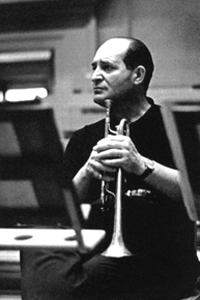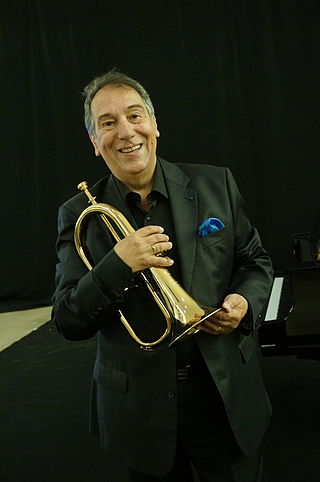Life and work
The composer Otto is known for his trumpet concerto in E-flat Major, which is dated about 1770. [1] [2] The original performing parts are indicated dell Signe Otto on the title page. The only surviving copy of the composition is held in the Fürst zu Bentheimsche Musikaliensammlung Burgsteinfurt , now in the custody of the Universitäts- und Landesbibliothek Münster. [3] [4] It is documented that the copies were acquired on behalf of Count Louis of Bentheim and Steinfurt by the court chapel's trumpeter named Preger. Together with another trumpet concerto from a likewise unknown composer named Signor Laue , the sheet music arrived in December 1803 from Gotha. However, as Preger left the chapel already in 1804, and the parts are in an almost untouched condition, it seems possible that both concertos may have never been performed in the concert hall of the Steinfurter Bagno . [2]
Nothing is currently known about Otto's life. Since the first recording of his concerto in 1981, [5] he is referred to as Luigi Otto in most releases, although there seems to exist no source for the first name. The Répertoire International des Sources Musicales (RISM) associates Otto with a certain Johann (Giovanni) Otto, of whom performing parts of two symphonies have survived in the Herzog August Library in Wolfenbüttel, although the attribution is conjectural. [6] Other musicians named "Otto", who have been proposed, include the composer Franz Otto (1730–1805) from Glatz (Silesia), the song composer Carl Otto from Mainz or the Augustinin canon Laurentius Justinianus Ott (1748–1802) from Weyarn. [1] [2]
The concerto has been recorded by notable trumpeters like Maurice André, [5] Ludwig Güttler, [7] Otto Sauter [8] [9] and Krisztián Kováts. [10] [11]

A sackbut is an early form of the trombone used during the Renaissance and Baroque eras. A sackbut has the characteristic telescopic slide of a trombone, used to vary the length of the tube to change pitch, but is distinct from later trombones by its smaller, more cylindrically-proportioned bore, and its less-flared bell. Unlike the earlier slide trumpet from which it evolved, the sackbut possesses a U-shaped slide with two parallel sliding tubes, rather than just one.

Francesco Maria Veracini was an Italian composer and violinist, perhaps best known for his sets of violin sonatas. As a composer, according to Manfred Bukofzer, "His individual, if not subjective, style has no precedent in baroque music and clearly heralds the end of the entire era", while Luigi Torchi maintained that "he rescued the imperiled music of the eighteenth century", His contemporary, Charles Burney, held that "he had certainly a great share of whim and caprice, but he built his freaks on a good foundation, being an excellent contrapuntist". The asteroid 10875 Veracini was named after him.

The keyed trumpet is a cylindrical-bore brass instrument in the trumpet family that makes use of tone holes operated by keys to alter pitch and provide a full chromatic scale, rather than extending the length of tubing with a slide or valves. It was developed from the natural trumpet and reached its high-point in popularity around the turn of the nineteenth century, but waned with the invention of valves in the 1820s and the subsequent emergence of the modern valved trumpet. It is rarely seen in modern performances.

Gottfried Heinrich Stölzel was a German composer of the Baroque era.
Johann Baptist Georg Neruda was a Czech classical composer, violinist and cellist.

Roger Louis Voisin was an American classical trumpeter. In 1959, The New York Times called him "one of the best-known trumpeters in this country."

The cornettino is the descant instrument of the cornetto family. Cornettini usually have a primary scale of C or D major, with middle C or the adjacent D the pedal note of the instrument. The regular cornett is the 'treble' instrument of the family.

The piccolo trumpet is the smallest member of the trumpet family, pitched one octave higher than the standard B♭ trumpet. Most piccolo trumpets are built to play in either B♭ or A, using a separate leadpipe for each key. The tubing in the B♭ piccolo trumpet is one-half the length of that in a standard B♭ trumpet. Piccolo trumpets in G, F, and even high C are also manufactured, but are rarer.
The Strathclyde Concertos are a series of ten orchestral works by the English composer Sir Peter Maxwell Davies.
An organ concerto is an orchestral piece of music in which a pipe organ soloist is accompanied by an an orchestra, although some works exist with the name "concerto" which are for organ alone.

Guy Touvron was a French classical trumpet player and music teacher. He was an accomplished soloist, having played with some of Europe's leading orchestras. He premiered several prominent trumpet concertos written for him. Touvron gave over 3,500 concerts, made over 120 recordings, and won several prizes.

The trumpet repertoire consists of solo literature and orchestral or, more commonly, band parts written for the trumpet. Tracings its origins to 1500 BC, the trumpet is a musical instrument with the highest register in the brass family.
A trumpet concerto is a concerto for solo trumpet and instrumental ensemble, customarily the orchestra. Such works have been written from the Baroque period, when the solo concerto form was first developed, up through the present day. Although comparatively rare compared to concertos for other instruments, some major composers have contributed to the trumpet concerto repertoire, such as Joseph Haydn in his Trumpet Concerto in E-flat.

Harald Feller is a German organist, choral conductor and composer teaching at the Hochschule für Musik und Theater München. He was awarded the 1983 Grand Prix du Disque Liszt.

Otto Sauter is a German trumpet soloist, who specializes in the piccolo trumpet.
Performances of Johann Sebastian Bach's Magnificat come in three formats:
- D major version, BWV 243 with the twelve movements of that version;
- D major version, with the Christmas interpolations from the earlier version BWV 243a transposed and inserted after movements 2, 5, 7 and 9.
- E flat major version, BWV 243a. The difference with the previous format is not only the key signature, there are also differences in orchestration, e.g. in the earlier version flutes are not part of the tutti, so do not play in the choral movements 1, 7 and 12, and a trumpet solo in movement 10 instead of the later unison oboes. Other differences are minor, but there is for instance a slightly harsher harmony near the end of movement 4 in the earlier version.
The Concerto, BWV 525a, is a trio sonata in C major for violin, cello and basso continuo, based on material otherwise found in Johann Sebastian Bach's first Organ Sonata, BWV 525, and Flute Sonata in A major, BWV 1032. The oldest extant manuscript containing the BWV 525a arrangement, D-B Mus.ms. Bach St 345, is dated to the middle of the 18th century. Although this version of Bach's sonata movements may have originated during his lifetime in the circle around him, it seems unlikely that the composer supervised, or even ordered, the manufacture of the string trio adaptation, thus the arrangement has been listed in BWV Anh. II, that is the Anhang (Anh.) of doubtful works, in the 1998 edition of the Bach-Werke-Verzeichnis (BWV). Breitkopf & Härtel published BWV 525a in 1965. Digital facsimiles of 18th- and 19th-century manuscript copies of the arrangement, in which the sonata is titled "Concerto", became available in the 21st century.

Carole Dawn Reinhart is an American musician. She is a trumpet soloist and Professor Emeritus at the University of Music and Performing Arts Vienna.











